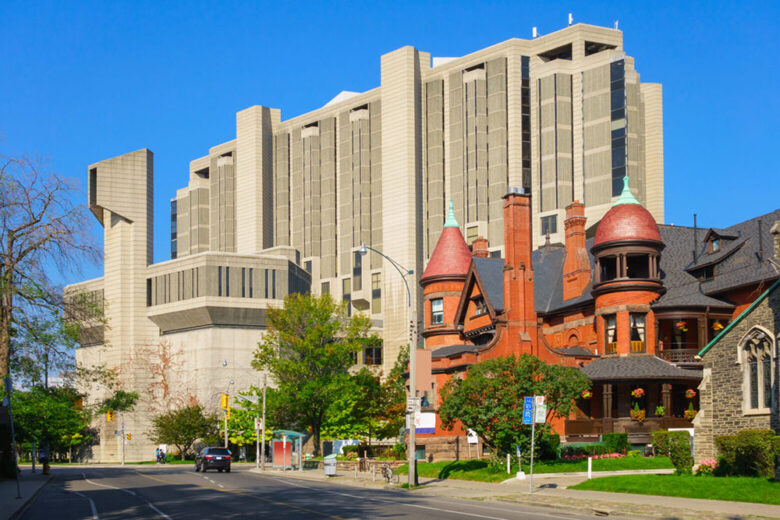Sector: Education
University of Toronto
Robarts Library, Reading Room Renovation
The Robarts Library, renowned as an example of the 'Brutalist' style of architecture, stands as one of Canada's largest academic library buildings, serving as a cornerstone of scholarly pursuit at the University of Toronto.
HH Angus provided mechanical and electrical engineering services, as well as design consulting for IMIT and lighting, for the renovation of the Library's fourth floor Reading Room.
The project, aimed at modernizing the library's facilities to accommodate contemporary learning paradigms, posed several intricate challenges. One notable challenge involved the intricate design of cabling for security and telecoms within the limited capacity channels of the floor slab, while ensuring the preservation of the library's architectural integrity. Moreover, the integration of wireless thermostats for HVAC control demanded meticulous planning to guarantee effective functionality while maintaining the library's iconic aesthetic.
In response to the evolving needs of the campus community, the renovated space has been thoughtfully curated to foster a conducive environment for study, collaboration, and digital scholarship. Individual study areas, equipped with state-of-the-art digital stations and consultation rooms, offer students and faculty alike the resources they need to thrive academically. Additionally, the incorporation of light therapy zones underscores a commitment to promoting wellness and inclusivity within the Library's patrons.
Improved accessibility was a key aspect of this renovation, featuring new study spots with adjustable desk heights, versatile seating configurations, and customizable lighting options, ensuring that all user's needs are considered. As well, strategic wayfinding elements and clear sightlines have been implemented to facilitate seamless navigation throughout the revitalized space.
SERVICES
Mechanical Engineering | Electrical Engineering | IMIT Consultant | Lighting Consultant
PROJECT FEATURES
20,300 ft2 space | Accessible study areas | Integration of building systems
LOCATION
Toronto, Ontario

Enhanced environments
The Library renovation is a significant advancement in the modernization of an academic institution, and underscores UofT's dedication to enhancing the built environment for all users.
Fanshawe College
IoT Data Lake
The College’s overarching goal was to streamline their data management process by consolidating disparate IoT platforms into a single accessible platform for measurement and research.
Fanshawe College needed a comprehensive data lake for all campus IoT data, beginning with two solar panel arrays. Their existing process involved physically going to each building’s measurement platform to download its data, merge the information in Excel format and perform a manual analysis.
HH Angus served as smart building consultants to the project, providing digital design services. We reprogrammed the PLCs (programmable logic controllers) of the solar panel arrays, enabling data transmission to AWS IoT core. The resulting data is now stored in a data lake where it is presented with analysis on a centralized dashboard, providing a unified and efficient solution to the College’s data management challenges.
One of the challenges of the project centered on communications and technical access. Collaboration with multiple academic and IT departments proved challenging due to communication issues with various stakeholders involved in the original solar panel array. To address this, our team coordinated multi-department troubleshooting meetings, fostering a collaborative atmosphere that was focused on progress.
Also, gaining access to the PLCs for essential programming changes became complicated due to staff turnover at the client. An unintended consequence of this was that new staff members were unfamiliar with the PLCs. To remedy this, our team assumed more of a technical advisory role than had been anticipated originally, to the point of involving technical support from the PLC manufacturer to assist the College’s technicians. Solving these issues underscores the project team’s adaptability in overcoming unexpected challenges.
SERVICES
Smart Building Consultants
PROJECT FEATURES
Comprehensive data lake for all campus IoT data | Centralized dashboard provides data analysis and data management | Status: Completed 2023, with ongoing maintenance contract
LOCATION
London, Ontario
KEY SCOPE ELEMENTS
Hardware-free data retrieval from solar panels | Reprogrammed PLCs for AWS data transmission | Advanced data analysis with local utility rates
Collège Bois-de-Boulogne
Server Room Air Conditioning
Pavilion Saint-Paul
One of the challenges of this project was to replace the main and redundant cooling systems in the server room while maintaining operations and minimizing impact on the College.
HH Angus’ scope of work for this project included analyzing the mechanical and electrical infrastructure of the server room, and proposing permanent corrective solutions. It also included implementation of solutions to provide redundancy for the mechanical infrastructure to guarantee full operation of the servers in the event of a critical power emergency or failure of the server room's main cooling system.
In order to analyze the existing installations, we performed site visits and surveys, and interviewed technicians responsible for the server room to gather as much information as possible about the existing installation, including any ongoing issues. We also reviewed and analyzed plans for the existing installation and performed a condition assessment - chilled water and glycol piping, insulation, ventilation ducts, electrical systems serving the equipment, and control systems - and took measurements in the mechanical and server rooms to ensure the new equipment could be properly installed while still providing space for maintenance work.
Following our analysis, we produced a report outlining the scope of work to refurbish the server room's cooling systems (main and redundant systems), ensuring the installation complied with current codes and standards. We produced mechanical and electrical drawings and specifications, including proposed solutions and equipment selection, and consulted with vendors to identify optimal solutions to meet the client’s requirements. During the tender process, we reviewed bids submitted by the contractor and provided recommendations to the College.
The intention was to complete this work over the summer when classes were not in session. Due to COVID-related delays in production of the necessary equipment, the work could not be completed on the original schedule and had to be undertaken when students were back in class. We worked very closely with stakeholders to avoid disruption to the students, with some work being completed before and after class or on weekends.
SERVICES
Mechanical Engineering | Electrical Engineering
PROJECT FEATURES
Analysis of mechanical and electrical infrastructure | Recommendations for permanent corrective solutions | Infrastructure redundancy in the event of critical power emergency | Status: Completed 2022
LOCATION
Montreal, Quebec
KEY SCOPE ELEMENTS
Analysis of existing equipment and installations | Design of new cooling systems
Northern Alberta Institute of Technology (NAIT)
‘Smart Campus’ Strategy, Planning and Technical Requirements
Northern Alberta Institute of Technology (NAIT) engaged HH Angus to develop the ‘Smart Campus’ strategy, planning and technical requirements. These deliverables will guide NAIT forward as a leading polytechnic in Canada to attract students, donors and researchers, while supporting environmental causes and the student experience.
The Angus Connect team led a multi-disciplinary Smart Campus consortium of consulting firms that brought together deep expertise in digital solutions and engineering disciplines. Some of the exciting aspects of the Smart Campus project included a campus integrated command centre, IoT sensor rich environment, energy management, smart building standards with BIM and Digital Twins, a future state network architecture including a spectrum management plan for Wi-Fi and cellular, with a focus on 5G-enabled devices. The incorporation of these emerging technologies will assist NAIT in achieving its organizational goals.
This project required a broad engagement of stakeholders and subject matter experts; a consulting team of 24 subject matter experts and project management joined forces to prepare a smart campus strategy.
Key services provided and deliverables included:
- Smart Campus Design Guidelines, documenting how smart features should be incorporated throughout the design
- Integration Design: Integration Requirements, Use Cases, and Integration Matrix to inform a future Smart Campus Integration Hub architecture and Master System Integration responsibilities
- Analytics: Analytical Model development to inform future Digital Twin insights
- Governance
It quickly became apparent that setting up the right decision makers and creating an advisory committee would be key to a well thought out strategy. Our team led the governance, oversight and direction setting with the committee, and, the project was managed through virtual engagement.
SERVICES
Stakeholder engagement | Desktop studies | Strategy & Roadmap development | Governance | Integration design | Analytics
PROJECT FEATURES
Post-Secondary | Visioning workshops | Technical requirements | Modeling | Standards and operating procedures | Completion: Q4 2022 (Est)
LOCATION
Edmonton, Alberta
KEY SCOPE ELEMENTS
Smart campus strategy | Planning | Technical requirements

Visioning Workshops
The Angus Connect team has deep experience in organization-wide and campus digital strategy & visioning, technology specifications, smart buildings technologies, command centres, networking infrastructure design and integration, and energy management. Our consultants facilitated visioning workshops with the Steering Committee and senior leadership to understand the needs, goals and objectives of the organization. These sessions included discussion of best practices, industry standards, and showcased current and emerging technologies through the use of case studies. From these sessions, our team was able to synthesize the vision, principles, key evaluation criteria and future state (opening day) initiatives.
Systems Architecture
Additional workshops were held to gain a better understanding of the current systems and network architecture, with attendant discussions on gaps/pain points and ongoing projects. Using the outputs from the visioning workshops and the systems architecture workshops, our team developed a conceptual model of systems architecture with a basis of design report to guide the client from their network today to the network they need for the future Smart Campus.

Seneca College of Applied Arts and Technology
Garriock Hall Mechanical Retrofit
Located on the King City campus, Garriock Hall renovations are part of Seneca’s on-going expansion. The retrofitted heating system provides improved comfort for the campus’ 5,200 students.
HH Angus was engaged as prime consultant for a retrofit at one of the campus’ main academic buildings. Our scope included replacement and upgrade to:
- Twelve fan coil units, complete with additional coil elements
- Approximately 30 hot water cabinet unit heaters located throughout the building, along with additional Building Automation System (BAS) integration
- Dual-duct terminal boxes for approximately 2/3’s of the building. The terminal boxes themselves were upgraded from pneumatically controlled to digital controlled complete with BAS integration.
- Domestic hot water system
- Pool heating system
The project used low temperature heating water from a ground-source heat pump system. This increased the physical size of the replacement heaters, which required accompanying structural and architectural modifications.
Domestic hot water preheat was implemented to take advantage of the low temperature heating water from the heat pump system, and was implemented as part of the domestic hot water system replacement and upgrade. The upgrades included a new high efficiency condensing water heater paired with a heating water to domestic water heat exchanger.
The pool heating system was not operational prior to the project. It was made functional and upgraded to take advantage of the low temperature heating water available from the heat pump system, by replacing the heat exchanger and adding additional controls.
Dual duct terminal boxes upgrades included replacing the terminal boxes to implement Variable Air Volume (VAV) control. In a few areas, existing single duct VAV terminal boxes were replaced with those equipped with reheat coils to facilitate occupant comfort.
The project timeline was aggressive, with engineering design starting late May 2019 and tendering in late August 2019. The project took advantage of the 2019 Christmas break to complete the majority of construction in order to minimize impacts to the occupants.
Image courtesy of Google Maps
SERVICES
Prime Consultant | Mechanical Engineering
PROJECT FEATURES
Twelve fan coil units | ~ 30 hot water cabinet unit heaters | Additional BAS integration | Dual-duct terminal boxes, upgraded from pneumatically controlled to digital control, complete with BAS integration | Domestic hot water system | Pool heating system
LOCATION
King City, Ontario
KEY SCOPE ELEMENTS
Heating plant uses ground source heat pump to deliver low temperature heating water | Compressed project schedule to meet heating season deadline | Unique dual-duct HVAC system being modernized and upgraded for re-use
